
Introduction
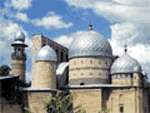 Ancient cities of Uzbekistan were located on the ancient Silk Road, the trading route between China and the West. The route took its name from silk, the commodity most in demand in Europe from China during the Roman period. Some of the most influential and savage conquerors came and ruled these lands.
Ancient cities of Uzbekistan were located on the ancient Silk Road, the trading route between China and the West. The route took its name from silk, the commodity most in demand in Europe from China during the Roman period. Some of the most influential and savage conquerors came and ruled these lands.
Alexander the Great set up at least 8 cities in Central Asia between 334 – 323 BC before the caravans began traveling through the Silk Road after around 138 BC China opened its border to trade. Between 484 – 1150 Huns, Turks and Arabs came from the west and the latest brought with them a new religion of Islam.
Many mosques and Madrassahs were built in Uzbekistan cities of Samarkand, Bukhara and Khiva during this period, including remaining structures of the Samanids. Most of the cities were destroyed during the invasion of the Genghis Khan in 1220. Later Timur, known also as Tamerlane, resurrected once famous cities by using the labor of slaves and artists captured during successful crusades. Timur conquered Persia, captured Baghdad, and lead expeditions to Anatolia and India. Most of the architecture that is found in Samarkand was build by Timur and his grandson Ulugbek.
The major cities in Uzbekistan are: Tashkent, Samarkand, Bukhara, Shakhrisabz, Khiva, Karshi, Urgench, Termez, Nukus and Fergana Valley Cities(Fergana, Margilan, Andijan, Kokand, Namangan):
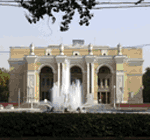 – Tashkent is probably the oldest city of Uzbekistan founded during the 1st century BC. First the Mongols and then the Timurids ruled Tashkent until the late 15th century. Today, Tashkent is the capital city of Uzbekistan.
– Tashkent is probably the oldest city of Uzbekistan founded during the 1st century BC. First the Mongols and then the Timurids ruled Tashkent until the late 15th century. Today, Tashkent is the capital city of Uzbekistan.
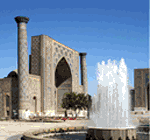 – Samarkand is one of the oldest Uzbek cities. This city was founded during the middle of the first century BC , formerly named as Marakanda and later known as Afrosiab. It was the capital of the powerful ‘State God’ – Emir Timur. Most of the monuments of Samarkand was build by Timur and his grandson Ulugbek.
– Samarkand is one of the oldest Uzbek cities. This city was founded during the middle of the first century BC , formerly named as Marakanda and later known as Afrosiab. It was the capital of the powerful ‘State God’ – Emir Timur. Most of the monuments of Samarkand was build by Timur and his grandson Ulugbek.
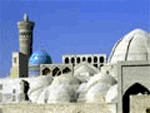 – Bukhara was established in the 8th century. Originally it was center of an expanding Islamic kingdom and gradually became the core region for trade and education center well known in Central Asia. Bukhara is replete with fine Islamic architecture.
– Bukhara was established in the 8th century. Originally it was center of an expanding Islamic kingdom and gradually became the core region for trade and education center well known in Central Asia. Bukhara is replete with fine Islamic architecture.
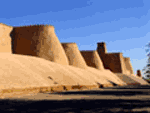 – Khiva is best known as a museum city. The age of this city is approximately 900 years. It developed as a modern city in the 19th century. This city has many scientific centers of astronomy, mathematics, and medicine since decades. The narrow streets with small courtyards through the wooden carved doors alongside are the unique features of the city.
– Khiva is best known as a museum city. The age of this city is approximately 900 years. It developed as a modern city in the 19th century. This city has many scientific centers of astronomy, mathematics, and medicine since decades. The narrow streets with small courtyards through the wooden carved doors alongside are the unique features of the city.
